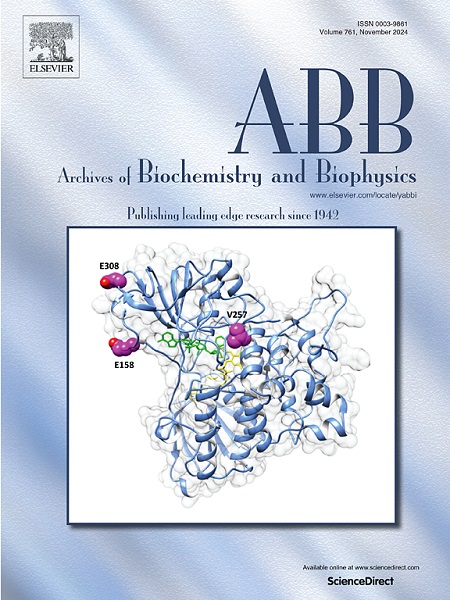The effect of acute hypoxic exercise on the protein kinase A/ arachidonic acid/ transient receptor potential vanilloid 4 pathway in the prefrontal cortex of rats
IF 3.8
3区 生物学
Q2 BIOCHEMISTRY & MOLECULAR BIOLOGY
引用次数: 0
Abstract
Acute hypoxic exercise will cause insufficient oxygen supply in brain tissue, and a succession of variations such as central dysfunction will occur. For example, the muscles don't have an adequate supply of oxygen, which leads to decrease in exercise capacity (Imray et al., 2005) [1]. The prefrontal cortex in the brain is primarily responsible for regulating the executive functions of the brain. TRPV4 channel is a cation channel with permeability to Ca2+. Signals such as hypotonic solution stimulation, cell swelling, temperature stimulation, mechanical stimulation, arachidonic acid and its metabolites can activate TRPV4 channel.
Purpose
In conditions of ischemia and hypoxia, the central nervous system of the brain is damaged. Therefore, studying the biological mechanism of TRPV4 pathway can help prevent the damage caused by cerebral ischemia and hypoxia to the human.
Results
Studies have found that PKA-mediated phosphorylation at Ser-824 affects AA. This is an important signaling pathway for coronary dilatation. This signaling pathway can activate TRPV4 channels. Therefore, we studied the effect of acute hypoxic exercise on the PKA/AA/TRPV4 pathway in the prefrontal cortex of rats. Furthermore, we concluded that the hypoxic environment can shorten the time of increasing load exercise in rats. In this way, the rat entered a state of exhaustion in advance, and the exercise ability was significantly reduced. After further study, blocking TRPV4 channel can prolong the time of incremental load exercise in hypoxic environment, and the exercise ability is improved. Acute hypoxic exercise led to an increase in the concentration of 14,15-EET, which was speculated to be one of the reasons for the increased expression of TRPV4 channels. Acute hypoxic exercise can activate the PKA/AA/TRPV4 signaling pathway in the prefrontal cortex of rats. Further research on blocking the TRPV4 channel can alleviate the activation of the PKA/AA/TRPV4 signaling pathway in the prefrontal cortex of rats by acute hypoxic exercise.
Conclusion
These results suggest that blocking the TRPV4 channel may be one of the ways to reduce the damage and apoptosis of prefrontal cortex cells in rats due to acute hypoxic exercise. In future studies, multiple time points will be selected for collection. Alternatively, TRPV4 agonists, PKA agonists or blockers and 14,15-EET agonists or blockers can be added for further pathway validation. To provide a biological mechanism for the study of nutrient targets on the problem of reduced exercise capacity when military personnel and travel enthusiasts first went to the plateau. Better medical reference for athletes training at high altitudes or patients with respiratory issues.

急性缺氧运动对大鼠前额叶皮层蛋白激酶 A/花生四烯酸/瞬时受体电位香草素 4 通路的影响
急性缺氧运动会导致脑组织供氧不足,出现中枢功能障碍等一系列变化。例如,肌肉得不到充足的氧气供应,导致运动能力下降[1]。大脑前额叶皮层主要负责调节大脑的执行功能。TRPV4 通道是一种对 Ca2+ 有通透性的阳离子通道。低渗溶液刺激、细胞肿胀、温度刺激、机械刺激、花生四烯酸及其代谢产物等信号均可激活 TRPV4 通道。因此,研究 TRPV4 通路的生物学机制有助于预防脑缺血和缺氧对人体造成的损害:研究发现,PKA 介导的 Ser-824 处磷酸化会影响 AA。这是冠状动脉扩张的重要信号通路。该信号通路可激活 TRPV4 通道。因此,我们研究了急性缺氧运动对大鼠前额叶皮层 PKA/AA/TRPV4 通路的影响。此外,我们还得出结论,缺氧环境可以缩短大鼠增加负荷运动的时间。这样,大鼠提前进入衰竭状态,运动能力明显下降。经过进一步研究,阻断 TRPV4 通道可延长缺氧环境下增量运动的时间,运动能力得到提高。急性缺氧运动导致 14,15-EET 浓度增加,推测这是 TRPV4 通道表达增加的原因之一。急性缺氧运动可激活大鼠前额叶皮层的 PKA/AA/TRPV4 信号通路。进一步研究发现,阻断TRPV4通道可以缓解急性缺氧运动对大鼠前额叶皮层PKA/AA/TRPV4信号通路的激活:这些结果表明,阻断TRPV4通道可能是减少急性缺氧运动对大鼠前额叶皮层细胞损伤和凋亡的方法之一。在今后的研究中,将选择多个时间点进行采集。此外,还可以添加 TRPV4 激动剂、PKA 激动剂或阻断剂以及 14,15-EET 激动剂或阻断剂,以进一步验证通路。为军人和旅游爱好者初上高原时运动能力下降问题的营养目标研究提供生物学机制。为在高海拔地区训练的运动员或有呼吸系统问题的患者提供更好的医疗参考。
本文章由计算机程序翻译,如有差异,请以英文原文为准。
求助全文
约1分钟内获得全文
求助全文
来源期刊

Archives of biochemistry and biophysics
生物-生化与分子生物学
CiteScore
7.40
自引率
0.00%
发文量
245
审稿时长
26 days
期刊介绍:
Archives of Biochemistry and Biophysics publishes quality original articles and reviews in the developing areas of biochemistry and biophysics.
Research Areas Include:
• Enzyme and protein structure, function, regulation. Folding, turnover, and post-translational processing
• Biological oxidations, free radical reactions, redox signaling, oxygenases, P450 reactions
• Signal transduction, receptors, membrane transport, intracellular signals. Cellular and integrated metabolism.
 求助内容:
求助内容: 应助结果提醒方式:
应助结果提醒方式:


